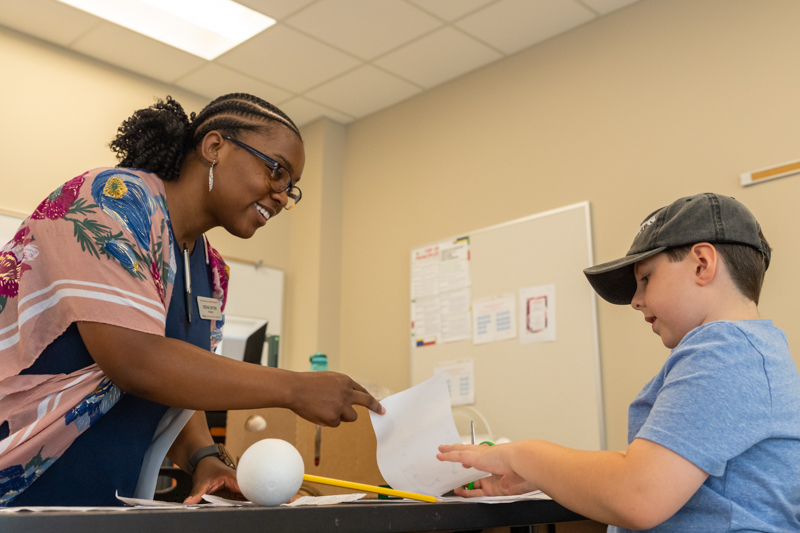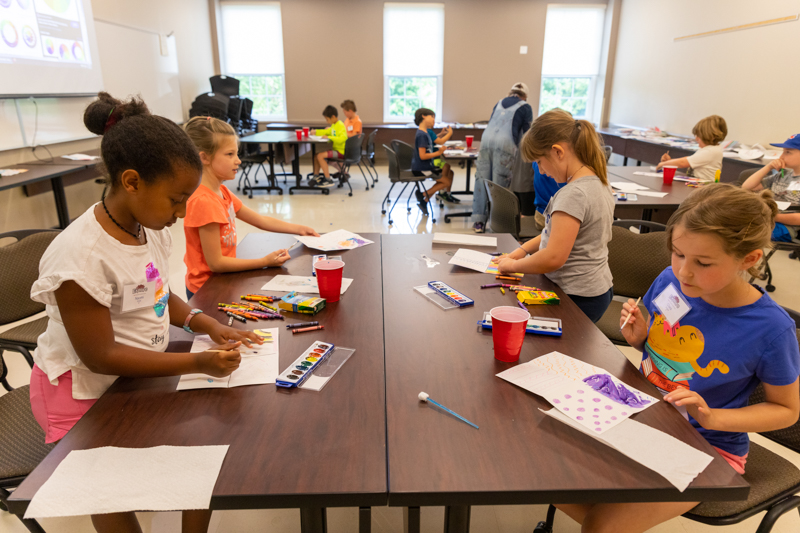by Erika Solberg
The theme of the week at this year’s Camp Explore is patterns, and one pattern our teachers are seeing is that of typical behaviors of high-interest and high-ability students!
In Language Arts, teacher Mary Evans of Bowling Green has observed many moments of such behaviors. On Monday, she shared with campers the book Paulie Diamond and the Magic Book by Alice Kuipers. The main character loves to make lists, including lists of all the books she has read, so one activity Mary’s students could choose to do was make their own list of their favorite books. She said, “Their lists revealed accelerated reading levels as well as high interest in reading.”
Mary also discussed literary devices with her students and asked them to raise their hands if they heard one of those devices used in the story: “Most of them knew what a simile was, and there are tons of them in the story, so they raised their hands a lot. They also quickly caught onto what hyperbole and alliteration are. You would not expect typical second and third graders to have as much interest in literary devices as these campers did.”
In Science, teacher Iesha Eaton of Elizabethtown encourages high-interest and high-ability behaviors by asking open-ended questions. Her students have been studying patterns in the environment this week, including pattens in the sun and moon and human and natural patterns. On Tuesday, she began their discussion of the moon by asking, “What do you already know?” and listing their responses on the board. Iesha noted that one student told her that “the moon is spheroid — egg-shaped — and I didn’t know that! I love when students have different experiences and bring them into the classroom. It’s one of my favorite things.”
Iesha has also seen perfectionism in her students, another common trait of high-ability and high-interest students: “Sometimes when I present new information or pose a question they don’t understand, they’re hesitant to answer for fear of not being right. But we’re all learners here — there is a learning process and no one is perfect, so I try to model that for them and point out when I make mistakes myself.”
Like Iesha, Math teacher Kierra Chandler of Bowling Green uses open-ended questions. Her students are spending the week studying geometry and building Ferris wheels. She says, “I love asking students what they notice. In a regular classroom, if I showed students a Ferris wheel and asked them what they noticed, they might point out it’s pink. But Camp Explore students really analyze it and notice all the shapes in it. I can push them further because they start off further along, and that’s exciting.”
Open questions also lead to communication among students. Kierra explains, “I really like having students talk to each other. I give them ‘think time’ and then ‘share time’ because students can hear ideas that they didn’t have. It gives them an opportunity to fill in a gap and lets them take ownership of their ideas by sharing them.”
Clowning and Art class, because they both have a creative focus, provide lots of chances for high-ability and high-interest students to abandon perfectionism and “right answers,” explore possibilities, and take their learning as far as and in whatever direction they want to go. Clowning teacher Nick Wilkins of Bowling Green uses a positive approach in his class where the word “can’t” is banned, thus encouraging a mindset where change is possible. Activities like juggling are open-ended with multiple choices to make — some students focus on learning to toss two scarves while others master tossing three bean bags.
Art teacher Andee Rudloff of Bowling Green encourages a classroom of curiosity and “no fear” where mistakes do not exist. She says, “I try to have them use as many different media as possible and get them to create what is in their heads rather than the way they think I might do it.” On Tuesday, students used markers to draw buildings with designs that used patterns and were related to the building’s purpose. Finished pieces included a building inspired by the Eiffel Tower, a helicopter landing port, tiny 3D buildings with swirly lines and repeating colors, and an art center covered in a rainbow pattern.
There is one other important pattern of behavior observed at Camp Explore that is common among high-ability and high-interest students: humor. Whether teacher Julie Boggess of Franklin, TN, is reading the camp a book full of silly highjinks during the opening session, Nick is cracking tried-and-true clown jokes, or Iesha is counting, “One, two … seven!” the responding giggles and laughter indicate that these campers are in the exact right place.


